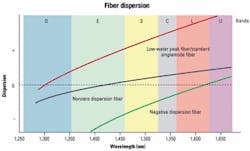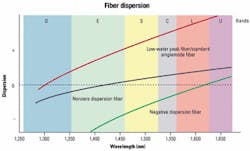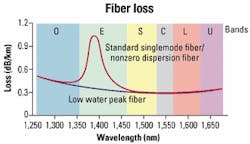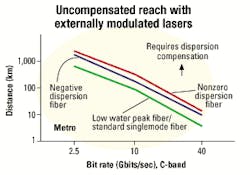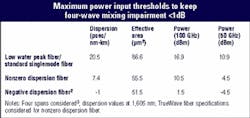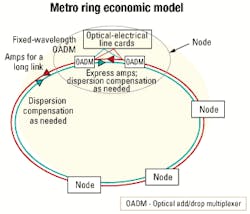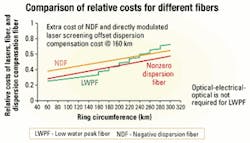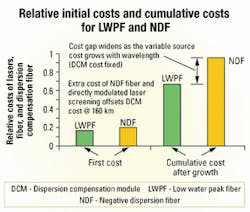Building metro fiber networks that last
A dual-fiber design offers the most cost-effective solution for metro networks.
DR. SANTANU DAS and DR. BERNARD EICHENBAUM, Lucent Technologies
In the late 1990s, service providers focused on deploying long-haul networks. Today, high-bandwidth enterprise applications are creating a demand for higher-bit-rate capabilities in the building-10-Gbit/sec risers and 1-Gbit/sec connections to the desktop. Metropolitan networks are getting squeezed from both sides.
Service providers must find ways to increase the metro network's capability to transport traffic among the long-haul and the various access networks. The right mix of fiber can help optimize system performance.
Metro networks are really a combination of at least three network segments: the metro access or edge (20 to 50 km in length), the metro backbone (50 to 200 km), and the regional metro (200 to 300 km). Access networks also play an important role in metro-network design. Cable TV-derived broadband access systems that deliver video and data by placing hybrid fiber/coax (HFC) nodes within a few kilometers of the subscriber are often engineered to back-haul traffic to headend sites as far as 75 km from the fiber nodes. Access systems that evolved from telephony architectures such as fiber-to-the-curb, fiber-to-the-business, and fiber-to-the-home typically have reaches up to 20 km.In addition to the variation in system length, service providers must be able to deliver multiple services to end users at different transmission wavelengths, using multiple protocols and a variety of bit rates. These same networks must also support emerging applications such as data-rich business access rings and upstream cable TV (digital reverse technologies).
The performance requirements of metro networks differ from those of long-haul networks. Unlike long-haul fiber, metro fiber must use bit rates between OC-3 (155 Mbits/sec) to OC-192 (10 Gbits/sec) and protocols such as Ethernet, Fast Ethernet, Gigabit Ethernet (GbE), 10-Gigabit Ethernet (10-GbE), Escon, Ficon, Fibre Channel, and subcarrier multiplexing to deliver voice, video, and data services to customers. Metro fiber must also meet the requirements of coarse WDM (CWDM) standards1 and DWDM and support existing systems.
Although 90% of all U.S. metro rings are less than 100 km in perimeter, the light-path distance between nodes can be as high as 200 km, depending on the network's protection mechanism. A high degree of optical transparency (distance without electronic regeneration) is desirable, but its effect on network expansion or service upgrades is an important consideration.Since the outside plant fixed costs (trenching, ducts, huts) in metro are almost twice as high as those for long-haul, metro fiber must be flexible enough to support generations of equipment designs and new transmission technologies such as Raman amplifiers. The 1,300-nm band will remain critical because of the widely deployed 1,300-nm-band transmission solutions and the emergence of 10-GbE. Due to the growth of broadband HFC access networks, the metro fiber should also support multiple signal formats such as quadrature amplitude modulation, vestigial sideband-amplitude modulation, and baseband digital pulse-code modulation.
These economic and technical requirements translate into metro fiber choices that may differ from what is used in long-haul. In some cases, one fiber type may not adequately handle conflicting requirements. In such cases, the use of hybrid cabling that incorporates two fiber types within a single cable can prove cost-effective and highly advantageous.
The fiber types to consider for metro and access applications include standard singlemode fiber (SSMF), low water peak fiber (LWPF) such as Lucent's AllWave, nonzero dispersion fiber (NZDF) with positive dispersion such as Lucent's TrueWave, and negative dispersion fiber (NDF) such as Corning MetroCor fiber. As shown in Figures 1 and 2, all fiber can be categorized on the basis of their dispersion and loss characteristics.
Both SSMF and LWPF have the same dispersion profile across the entire transmission band. Elimination of the loss peak at 1,385 nm defines LWPF (see Figure 2), allowing use of the low-dispersion (~8-psec/nm-km) 1,400-nm region. Usable WDM spectral capacity increases by >50% compared to SSMF. For LWPF, 1,385-nm loss is less than 1,310-nm loss (0.35 dB/km) and works within 1,310-nm-span engineering practices. NDF2, on the other hand, exhibits a higher loss of 0.4 dB/km and 0.5 dB/km at 1,385 nm and 1,310 nm, respectively, and may need span reengineering.
Most SONET systems are loss-limited, while newer optical add/drop multiplexing (OADM) systems may be dispersion-limited at high bit rates (~10 Gbits/sec) with directly modulated lasers (DML) or over long distances (>200 km). Note that electronic regeneration is not required to compensate for loss or dispersion and is used only to demultiplex traffic at a node. To combat dispersion impairment, compensation using dispersion compensating fiber (DCF) is a robust and reliable method available to SSMF, LWPF, and NZDF. On the other hand, NDF, which has D<0, relies on dispersion pre-compensation because of transient chirp of the transmitter to narrow pulses and to achieve distance requirements.Figure 3 shows the uncompensated reach (maximum transmission distance possible without extrinsic dispersion compensation) as a function of bit rates for externally modulated lasers (EMLs). Such sources have very narrow linewidth and are essentially chirp-free and so yield an upper bound for the uncompensated reach. Near 40 Gbits/sec and beyond, where DMLs are not suitable, the uncompensated reach falls off dramatically (e.g., <15 km for non-return-to-zero signaling), even for the best bit-rate-distance fibers such as NZDF.3 That means dispersion compensation is required as systems are upgraded to higher bit rates such as 40 Gbits/sec, no matter what metro distances are considered or which fibers are used. Hence, DCFs will be absolutely crucial to precisely compensate the whole EDFA band. DCF is currently available for the SSMF, LWPF, and NZDF, but not NDF. The technology of a negative-slope positive-dispersion fiber, the kind that will be required to compensate NDF, will remain a significant challenge. If and when such a DCF is realized, the associated cost is likely to be very high as well.
As shown in Figure 4, the compensated net dispersion remains within the tight ±50-psec/nm tolerance limit over the entire 1,500- to 1,600-nm re gion for SSMF, LWPF, and NZDF. In contrast, the residual net dispersion for NDF (shown compensated with SSMF) presents a significant cost penalty for 40-Gbit/sec DWDM.Apart from cost, a bigger concern is the dependence of transient chirp on laser bias, extinction ratio, and the modulating waveform rise/fall times. Pending complete characterization of these effects over laser aging and temperature variation (for systems using uncooled lasers), DCF will continue to be the more reliable technique for dispersion compensation in commercial systems.
Even when chromatic dispersion is adequately compensated, further system impairments are often present because of fiber nonlinearity. In particular, two issues are important from a metro/ access perspective: raw capacity (total bit rate over the system bandwidth) and isolation between different wavelength bands/channels. Raw capacity is typically constrained by four-wave mixing (FWM), and wavelength isolation is restricted by Raman crosstalk. Higher-dispersion, widely spaced channels, and low input power per channel mitigate FWM. Higher effective area (Aeff) reduces Raman crosstalk between services on different wavelength bands/channels. The Table shows the maximum power input (on a per-channel basis) to the fiber. LWPF, SSMF, and NZDF can support 100% more capacity than NDF in the L-band, since they retain superior FWM performance even for channel spacings <50 GHz.
Despite the surge of DWDM in C- and L-bands in the metro backbone, the need for the 1,300-nm band remains strong in the metro edge and access thanks to several market drivers:
- A large edge/access market, estimated to be 10 times that of the metro backbone, which is dominated by 1,300-nm-band transmission due to availability of low-cost sources such as uncooled DFBs, Fabry-Perot lasers, LEDs, and upcoming vertical-cavity surface-emitting lasers (VCSELs).
- The recent standardization in the IEEE 802.3 Gigabit Ethernet forum for two 1,300-nm-band solutions for 10-GbE and the burgeoning market for very-short-range (VSR) SONET.
- Progress toward the standardization of a full-spectrum CWDM wavelength grid to address cable TV digital reverse, metro access rings, and point-to-point applications (enterprise and Internet service-provider traffic aggregation) using uncooled lasers and lower-cost multiplexers/demultiplexers.
It is clear that metro fiber must be compatible with 1,300-nm-band transmission. Otherwise, a huge revenue base will remain untapped, and providers will need expensive optical transponders to convert the 1,300-nm band to 1,550 nm. LWPF and SSMF, by virtue of low dispersion in the 1,300-nm region, are ideally suited to this wavelength band, especially benefiting from the negligible chirp afforded by VCSELs and quantum dot lasers. NDF performance in the 1,300-nm band is likely to be significantly impaired at the higher bit rates (~OC-192), owing to its very high dispersion coefficient, while SSMF and LWPF offer the best 1,310-nm performance. NZDF with its -9-psec/nm-km dispersion coefficient at 1,310 nm, offers attractive performance between LWPF/SSMF and NDF, allowing better than twice the reach of NDF.
The inability to utilize a wide portion of the spectrum (1,360-1,440 nm) in SSMF due to the water peak is a constraint for future bandwidth/wavelength expansion. LWPF breaks this bottleneck with full-spectrum CWDM (1,260-1,625 nm in a 20-nm grid spacing) and DWDM to truly enable managed wavelength services. By using a wavelength band separator4, a carrier's carrier stands to reap revenue from additional wavelengths, with room for 150 100-GHz channels. Several proof-of-concept demonstrations and field trials in the 1,400-nm band show its promise. The advantages for using LWPF in the 1,400-nm band include:
- Extra wavelengths in a low-dispersion region enabling high bit rate and reach.
- Reduced cost from low-figure-of-merit filters and uncooled sources used in CWDM.
- The ability to support Raman amplification for the S-band.
- A better service and modulation format mix.
Some 1,400-nm components are already being produced and used. With the ITU standardization of CWDM1-a key enabler to volume-a grid for lasers will be in place. Standardization of wavelengths, rather than technology breakthroughs, is necessary for commercialization. With full-spectrum flexibility, carriers that build their networks with the 1,400-nm capability stand to provide the lowest cost per bit and full-spectrum connectivity.
Economic modeling of metro systems can address both ring and point-to-point architectures. Figure 5 shows the basic elements that enter into the economic modeling of a two-fiber metro ring.
To investigate relative costs among fiber types, a two-fiber ring that takes advantage of both OADM and dispersion compensation technologies is used. OADM and dispersion compensation are two technologies that can reduce the cost of modern optical networks by exploiting optical transparency since wavelengths that pass by a node do not incur OEO regeneration. Some published economic models ignore the advantages of OADM and rely on full OEO, which is misleading. In cases where optical transparency is desirable for ring evolution, the fiber choice affects not only fiber costs, but also laser and dispersion compensation costs. An economic model for a network that uses OADM captures these three cost categories. Figure 6 shows the initial costs of fibers, lasers, and dispersion compensation modules (DCMs) plotted against ring circumference.After five years, an assumed increase in demand drives the network to 48 wavelengths per node. Initially, NDF with screened, higher-cost DML sources is a costlier solution than using LWPF, lasers not screened for transient chirp, and DCMs. Since dispersion compensation is a one-time cost, the cost advantage of the LWPF solution increases as the number of lasers grows.
As in the C-band, LWPF yields a 30% cost savings over NDF in the 1,300- and 1,400-nm bands. LWPF offers similar benefits over SSMF when the additional capacity of the 1,400-nm band is taken into account. (This assertion is based on point-to-point analyses that assumed a given number of fibers or wavelengths on a route.)
When an application calls for a given number of fibers on a point-to-point route, the cost of that route on a per-wavelength basis is reduced with LWPF, because the entire cost, including construction, installation, and materials, is amortized over a greater number of transmission channels. As an example, for a 30-km, 96-fiber route with CWDM that supports 12 channels on SSMF and 16 channels on LWPF, a cost benefit of over $300 is calculated per channel for LWPF.When an application calls for a given number of optical channels on a point-to-point route, the total cost of that route is reduced if LWPF is used, because fewer fibers are needed. That saves on cable costs; materials and labor for splices, connectors, and crossconnects; and passive optical components. One model of an access route of 30 km with route diversity shows almost $500 per channel savings with LWPF as compared to SSMF.4
In short, economic modeling that exploits OADM rather than OEO and the benefits of 1,400-nm spectrum in metro architectures shows that LWPF has lower initial costs than NDF. These savings grow as the channel count increases and can range from 15% to 30% for fiber, DCF, and sources. For metro ring applications longer than 200 km, NZDF should be added to the solution for the lowest cost (see Figure 6). Also, the prove-in distance for NZDF will get shorter at higher bit rates, i.e., 10 and 40 Gbits/sec.
Many R&D initiatives will produce technologies for evolving low-cost, high-capacity networks. Here are just a few well-known candidates expected to provide strong cost or capacity benefits in metro systems:
- VCSELs at 1,300 nm.
- Closer channel spacing with <25 GHz in the C- and L-bands.
- Chirped-pulse WDM enabling >15,000 channels over the 1,280-1,625-nm spectrum.5
- Distributed Raman pumping at the low water peak to enable better use of the S-band.
New fiber facilities should anticipate these emerging technologies, or service providers may face a huge cost penalty to upgrade or overlay plant.
Here are our conclusions on the best optical-fiber choices for metro networks that must remain economically viable well into the future: Use LWPF for up to 200 km, NZDF for more than 200 km, and a composite cable of LWPF and NZDF for mixed distances. In other words, a practical-and highly strategic-approach is to place two fiber types such as NZDF and LWPF inside the same cable to take advantage of optimal performance over a cross section of distances, bit rates, and wavelength windows. Carriers needing fiber for combined metro access and regional rings benefit from including both LWPF and NZDF in their cables.
- NZDF is optimized for DWDM in the C- and L-bands, as traditional long-haul fiber transmission performance has remarkably and consistently demonstrated. It is also ideal for the "metro regional" market since it is unconstrained by laser source type. It links very compatibly with long-haul NZDF to provide the best overall network optical transparency.
- NDF is optimized for use with selected DMLs for operation in the C-band, resulting in sub-optimal transmission in every other wavelength band.
- SSMF's performance is a subset of LWPF; hence, greenfield deployment of SSMF provides no differentiating technology advantage. A slight first cost advantage is quickly obviated as bandwidth demands grow.
- LWPF is optimized for the 1,300- and 1,400-nm bands, and shares the proven performance of SSMF in the C- and L-bands. It is thus ideal for the "metro backbone" and "metro access" markets.
A dual-fiber solution using LWPF and NZDF delivers all the capabilities needed by service providers building me tro networks. Hybrid cable containing high-performance NZDF and LWPF offers best-in-class metro regional (>200 km), metro backbone, and metro access (<200 km) solutions. LWPF provides the maximum capacity and lowest cost in typical metro applications (200 km and less) and is compatible with legacy metro transmission systems using transmitters in the 1,300-nm wavelength band. NZDF enables transmission without dispersion compensation in the 1,550-nm band for long metro rings and for connecting through long-haul traffic.
A metro network is a major investment that must provide returns to service providers for many years. This solution will allow providers to build a metro network that lasts.
Dr. Santanu Das is director of metro and cable TV engineering and Dr. Bernard Eichenbaum is a distinguished member of the technical staff at Lucent Technologies' Fiber Optic Solutions division (Whippany, NJ).
- B. Eichenbaum, "Role develops for coarse WDM," Lightwave, May 2001.
- PI1302, "Corning MetroCor Fiber Product Information," 10/00.
- M.H. Eiselt, "The impact of non-linear fiber effects on fiber choice for ultimate transmission capacity," OFC 2000 Tech ni cal Digest, pp. 58-60.
- B. Eichenbaum, et al., 2000, "Opportun ities for revenue enhancement and cost reduction in metro rings and access networks enabled by the emerging standard low water peak fiber and new architectures," NFOEC 2000 Technical Proceedings.
- B.C. Collings, et al., "A 1021-channel WDM system," IEEE Photonics Technology Letters, Vol. 12, pp. 906-908.
